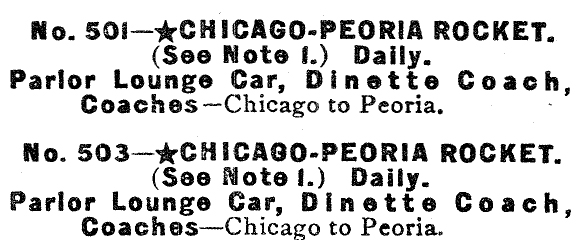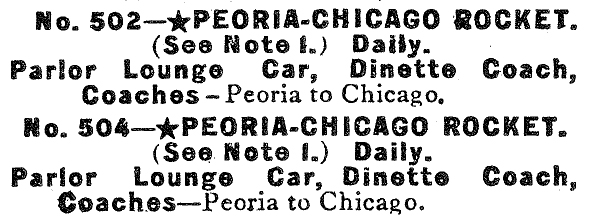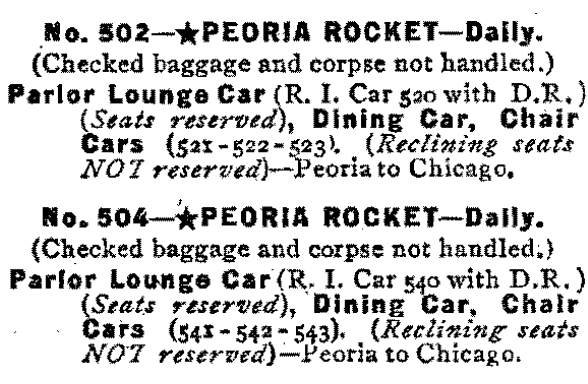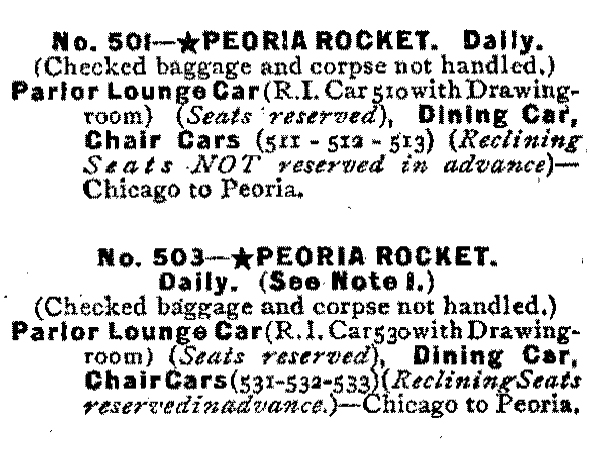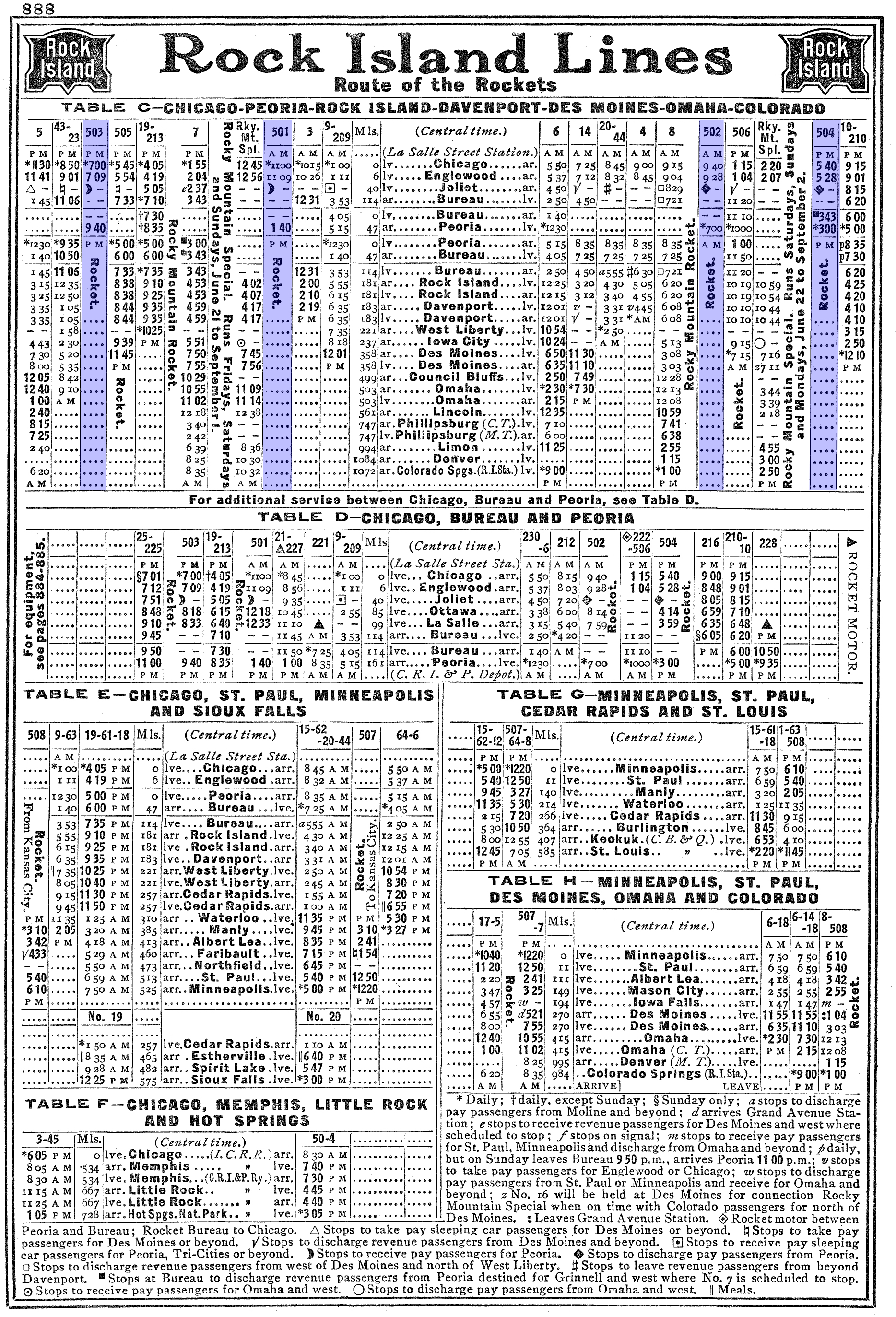"Peoria Rocket" (Train): Route, Consist, Timetable
Last revised: February 25, 2025
By: Adam Burns
The Peoria Rocket , or simply the Rocket, was a streamliner operated by the Chicago, Rock Island & Pacific Railroad - better known as the Rock Island - between Chicago and Peoria, Illinois.
The service began in 1937 and was one of several trains named the Rocket. These included the Peoria Rocket, Des Moines Rocket, Texas Rocket, Denver Rocket, Choctaw Rocket, Twin Star Rocket, Corn Belt Rocket, Kansas City Rocket, Zephyr Rocket, and Rocky Mountain Rocket.
Despite its always shaky financial status, the Rock Island immediately embraced the streamliner concept. Its early regional Rockets - like the Peoria Rocket - proved quite successful and led to several long-distance services such as the Rocky Mountain Rocket, Choctaw Rocket, and Zephyr Rocket.
Unfortunately, the Rock's declining state - and competition from other transportation modes - saw the Peoria service deteriorate rapidly after 1960. In addition, the railroad could not afford to join Amtrak and continued to operate a semblance of the Peoria Rocket until late 1978.
Photos
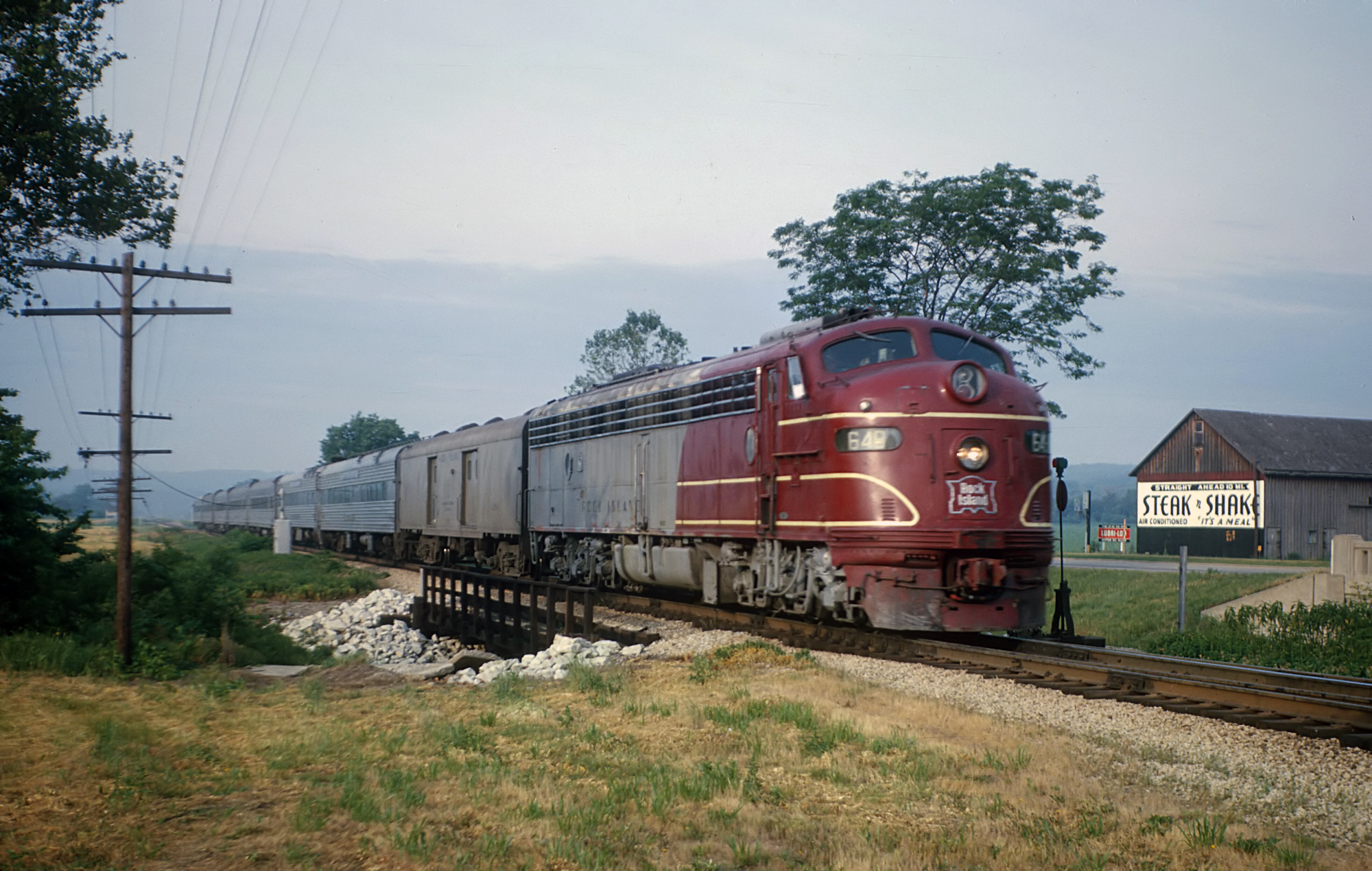 Rock Island E8A #649 has train 12, the "Peoria Rocket" approaching Mossville, Illinois in June, 1963. Roger Puta photo.
Rock Island E8A #649 has train 12, the "Peoria Rocket" approaching Mossville, Illinois in June, 1963. Roger Puta photo.Inauguration
The Peoria Rocket was an eminent example of the classic mid-20th-century named passenger trains. In his book, "Classic American Railroads," author Mike Schafer notes the Rockets provided fast and cheap coach-service on intermediate, day-length trips.
The name not only denoted speed but also recognized the railroad's first steam locomotive, the 4-4-0 "Rocket." This little engine had powered the Rock Island's first train between Chicago and Joliet on October 10, 1852.
When the streamliner craze hit in the nation during the mid-1930s, the Rock was quick to join in. In their book, "Streamliners: History Of A Railroad Icon," author's Mike Schafer and Joe Welsh note the railroad quickly ordered six sets of lightweight equipment from E.G. Budd Manufacturing.
The streamlined, semi-articulated cars included four sets of three cars (baggage-dinette-coach, standard coach, and coach-parlor observation) and two sets of four cars (baggage-dinette, two standard coaches, and a parlor-observation lounge). They were powered by Electro-Motive's 1,200 horsepower "TA" streamlined diesel, an early four-axle variant.
The Peoria Rocket included the four-car set. Its original consist was 32-seat dinette car #400 (Joliet), 60-seat coach #306 (Ottawa), 76-seat coache #300 (La Salle), and parlor-buffet-observation #450 (Peoria).
The train officially entered service on September 19, 1937. The short corridor - only 161 miles - enabled the train to make two round trips daily. It could make a run in just over 2 ½ hours while averaging 60 ½ mph.
The luxury service provided an exciting and convenient commute for passengers traveling between the two cities. It was also critical - and much appreciated - by businessmen regularly traveling between the two business hubs.
The Rocket was noted for its sleek design and state-of-the-art technology. The train was also adorned in a beautiful livery of crimson, red, and silver. Its first set of equipment, famously built by the Budd Company, comprised the equipment previously mentioned.
Consists
1940
1952
The amenities offered was a compelling factor in the train's popularity, with the baggage-dinette car offering buffet services during peak meal hours. The observation car, with large picture windows and comfortable chairs, provided an extraordinary view of the scenic Illinois landscapes.
In the late 1940s, the original trainsets began to wonder and were reassigned to other corners of the railroad's network. By the 1952 timetable, featured here, the train's consist included a parlor lounge (with drawing room), full diner, and reclining seat coaches.
The post-World War II era saw a general decline in passenger trains across the United States, and the Peoria Rocket was no exception. The amenities began to wane, and owing to economic constraints, the Rock Island decided to retract the less profitable routes.
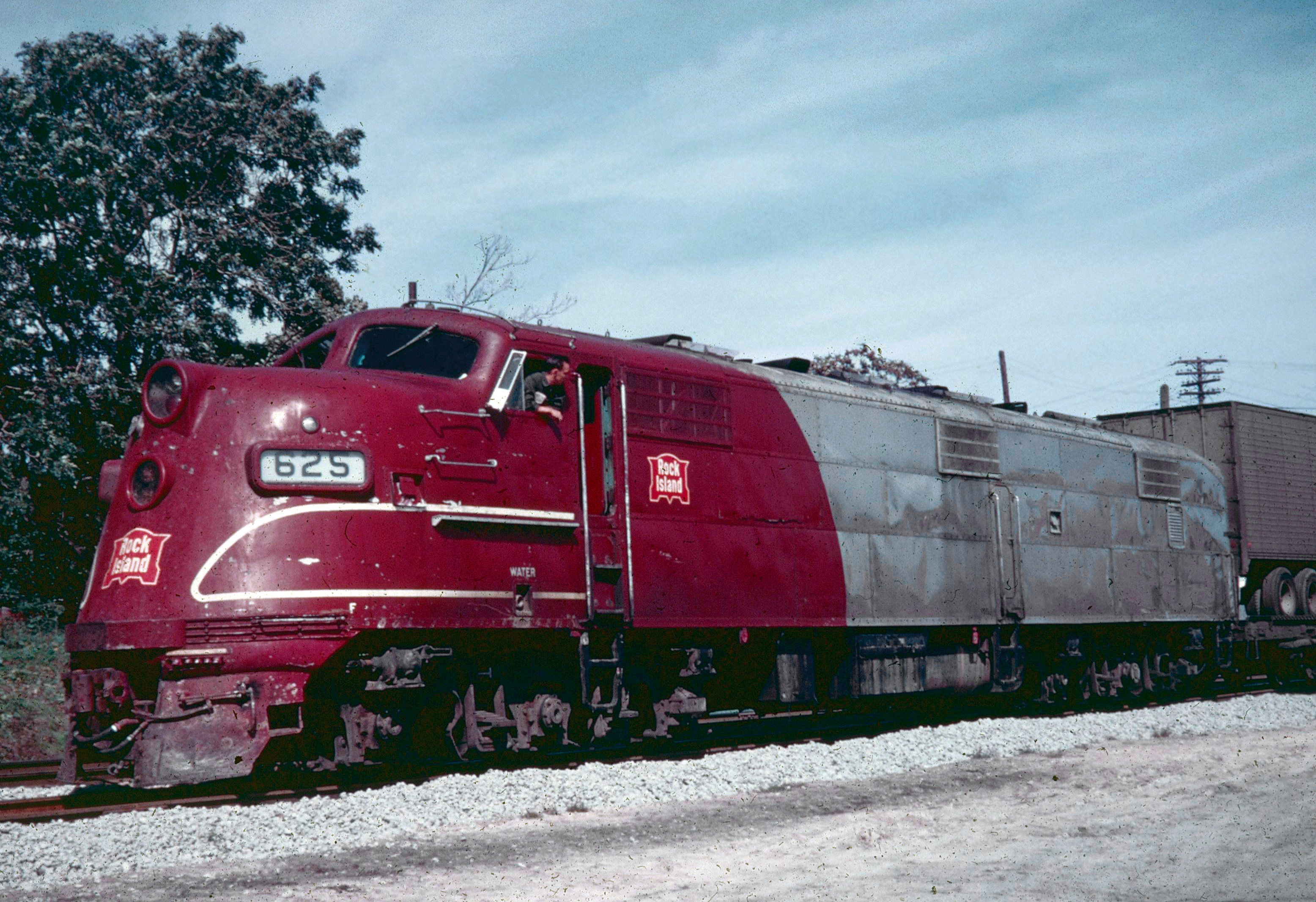 Rock Island E3A #625 is seen here at Peoria, Illinois with the "Peoria Rocket" in October, 1967. Originally out-shopped in 1939, she was traded in to EMD a few years after this photo was taken (September, 1969). Photographer unknown. American-Rails.com collection.
Rock Island E3A #625 is seen here at Peoria, Illinois with the "Peoria Rocket" in October, 1967. Originally out-shopped in 1939, she was traded in to EMD a few years after this photo was taken (September, 1969). Photographer unknown. American-Rails.com collection.Decline
In addition, the railroad was in serious financial decline by 1969. As Greg Schneider notes in his book, "Rock Island Requiem," that year the company lost $9.3 million despite having eliminated most passenger services from its system by that time.
After May 31, 1970 the Peoria Rocket was the last remaining intercity train still in operation. To sustain service the state of Illinois even provided a $1 million annual subsidy. Nevertheless, the railroad still had annual losses of more than $1 million.
After deciding it could not afford to join Amtrak, and with the state subsidy in hand, the Rock maintained two services throughout most of the 1970s; the Peoria Rocket (trains #11-12) and Quad Cities Rocket (train #5-6).
These rickety trains were hardly the glamorous and fast services the railroad had maintained through the early 1960s; slow orders and deteriorating track required more than 5 hours to complete each trip. Finally, 0n March 31, 1978, the Peoria Rocket ceased operations after four decades of service.
Timetables
1940
1952
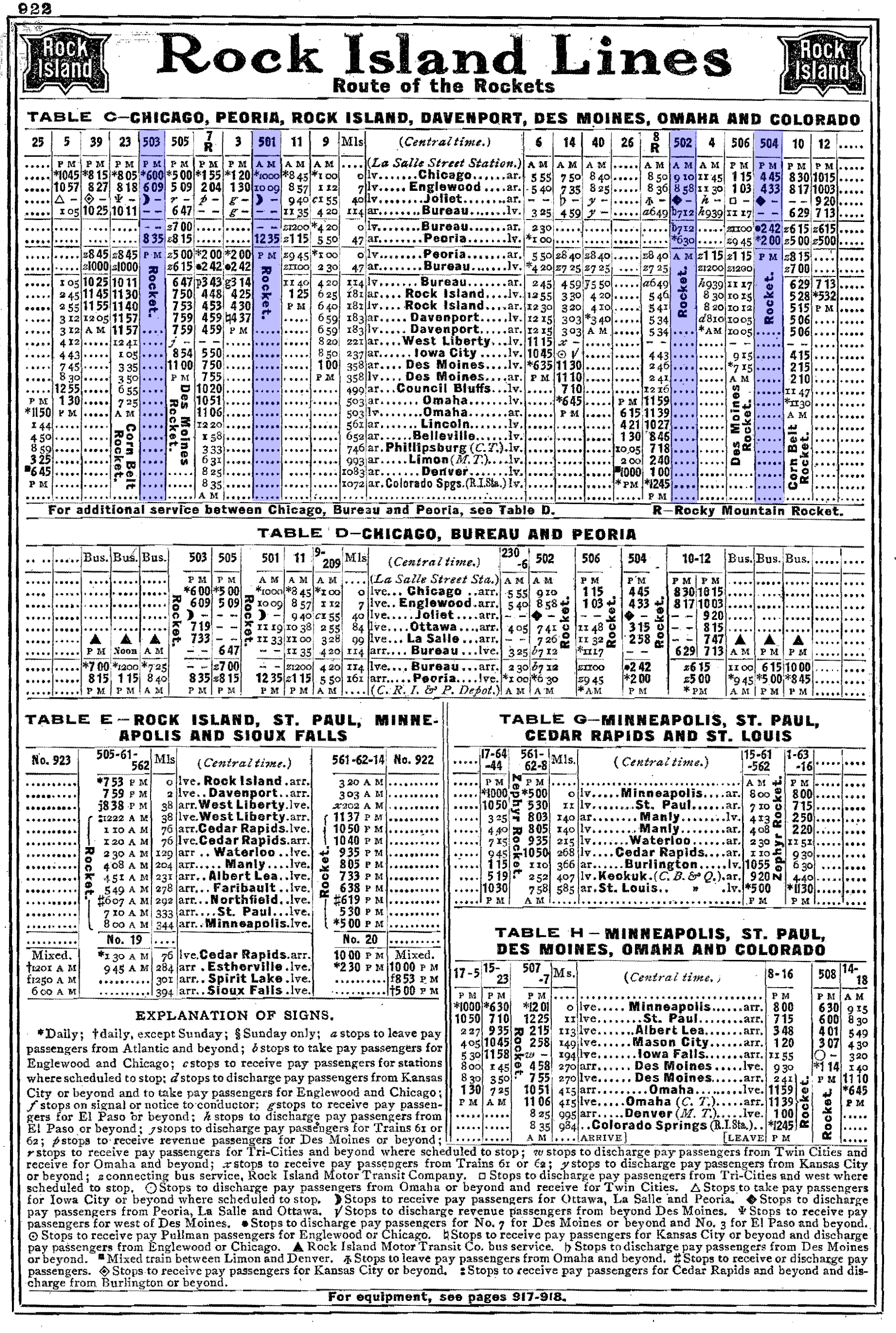
Legacy
Despite its closure, the memories of this incredible train endure in the hearts and minds of the people who had the privilege to experience its journey.
The Peoria Rocket remains a distinct chapter in the history of American railroads. Laden with the enchantment of a bygone era, tales of its exemplary service, and swift journeys across Illinois, the train truly symbolized the glamour and efficiency of mid-20th-century passenger rail service.
Today, it continues to inspire rail enthusiasts and historians for its contribution to intercity rail transportation and the larger narrative of American industrial history.
Sources
- Kelly, John. Rock Island Railroad, Photo Archive: Travel On The Rockets. Hudson: Iconografix, 2010.
- Marvel, Bill. Rock Island Line, The. Bloomington: Indiana University Press, 2013.
- Schneider, Gregory L. Rock Island Requiem: The Collapse Of A Mighty Fine Line. Lawrence: University Press Of Kansas, 2013.
- Schafer, Mike and Welsh, Joe. Streamliners, History of a Railroad Icon. St. Paul: MBI Publishing, 2003.
- Solomon, Brian. Streamliners: Locomotives And Trains In The Age Of Speed And Style. Minneapolis: Voyageur Press, 2015.

